Gao Huang
Collaborative Low-Rank Adaptation for Pre-Trained Vision Transformers
Dec 31, 2025Abstract:Low-rank adaptation (LoRA) has achieved remarkable success in fine-tuning pre-trained vision transformers for various downstream tasks. Existing studies mainly focus on exploring more parameter-efficient strategies or more effective representation learning schemes. However, these methods either sacrifice fine-tuning performance or introduce excessive trainable parameters, failing to strike a balance between learning performance and parameter efficiency. To address this problem, we propose a novel tuning method named collaborative low-rank adaptation (CLoRA) in this paper. CLoRA consists of base-space sharing and sample-agnostic diversity enhancement (SADE) components. To maintain parameter efficiency while expanding the learning capacity of low-rank modules (LRMs), base-space sharing allows all LRMs to share a set of down/up-projection spaces. In CLoRA, the low-rank matrices obtained from the shared spaces collaboratively construct each LRM. Since the representations extracted by these matrices may contain redundant information, SADE is employed to regularize the similarities among them to encourage diverse representations in the training process. We conduct extensive experiments on widely used image and point cloud datasets to evaluate the performance of CLoRA. Experimental results demonstrate that CLoRA strikes a better balance between learning performance and parameter efficiency, while requiring the fewest GFLOPs for point cloud analysis, compared with the state-of-the-art methods.
SenseNova-MARS: Empowering Multimodal Agentic Reasoning and Search via Reinforcement Learning
Dec 30, 2025Abstract:While Vision-Language Models (VLMs) can solve complex tasks through agentic reasoning, their capabilities remain largely constrained to text-oriented chain-of-thought or isolated tool invocation. They fail to exhibit the human-like proficiency required to seamlessly interleave dynamic tool manipulation with continuous reasoning, particularly in knowledge-intensive and visually complex scenarios that demand coordinated external tools such as search and image cropping. In this work, we introduce SenseNova-MARS, a novel Multimodal Agentic Reasoning and Search framework that empowers VLMs with interleaved visual reasoning and tool-use capabilities via reinforcement learning (RL). Specifically, SenseNova-MARS dynamically integrates the image search, text search, and image crop tools to tackle fine-grained and knowledge-intensive visual understanding challenges. In the RL stage, we propose the Batch-Normalized Group Sequence Policy Optimization (BN-GSPO) algorithm to improve the training stability and advance the model's ability to invoke tools and reason effectively. To comprehensively evaluate the agentic VLMs on complex visual tasks, we introduce the HR-MMSearch benchmark, the first search-oriented benchmark composed of high-resolution images with knowledge-intensive and search-driven questions. Experiments demonstrate that SenseNova-MARS achieves state-of-the-art performance on open-source search and fine-grained image understanding benchmarks. Specifically, on search-oriented benchmarks, SenseNova-MARS-8B scores 67.84 on MMSearch and 41.64 on HR-MMSearch, surpassing proprietary models such as Gemini-3-Flash and GPT-5. SenseNova-MARS represents a promising step toward agentic VLMs by providing effective and robust tool-use capabilities. To facilitate further research in this field, we will release all code, models, and datasets.
Vision Transformers are Circulant Attention Learners
Dec 25, 2025Abstract:The self-attention mechanism has been a key factor in the advancement of vision Transformers. However, its quadratic complexity imposes a heavy computational burden in high-resolution scenarios, restricting the practical application. Previous methods attempt to mitigate this issue by introducing handcrafted patterns such as locality or sparsity, which inevitably compromise model capacity. In this paper, we present a novel attention paradigm termed \textbf{Circulant Attention} by exploiting the inherent efficient pattern of self-attention. Specifically, we first identify that the self-attention matrix in vision Transformers often approximates the Block Circulant matrix with Circulant Blocks (BCCB), a kind of structured matrix whose multiplication with other matrices can be performed in $\mathcal{O}(N\log N)$ time. Leveraging this interesting pattern, we explicitly model the attention map as its nearest BCCB matrix and propose an efficient computation algorithm for fast calculation. The resulting approach closely mirrors vanilla self-attention, differing only in its use of BCCB matrices. Since our design is inspired by the inherent efficient paradigm, it not only delivers $\mathcal{O}(N\log N)$ computation complexity, but also largely maintains the capacity of standard self-attention. Extensive experiments on diverse visual tasks demonstrate the effectiveness of our approach, establishing circulant attention as a promising alternative to self-attention for vision Transformer architectures. Code is available at https://github.com/LeapLabTHU/Circulant-Attention.
Co-GRPO: Co-Optimized Group Relative Policy Optimization for Masked Diffusion Model
Dec 25, 2025Abstract:Recently, Masked Diffusion Models (MDMs) have shown promising potential across vision, language, and cross-modal generation. However, a notable discrepancy exists between their training and inference procedures. In particular, MDM inference is a multi-step, iterative process governed not only by the model itself but also by various schedules that dictate the token-decoding trajectory (e.g., how many tokens to decode at each step). In contrast, MDMs are typically trained using a simplified, single-step BERT-style objective that masks a subset of tokens and predicts all of them simultaneously. This step-level simplification fundamentally disconnects the training paradigm from the trajectory-level nature of inference, leaving the inference schedules never optimized during training. In this paper, we introduce Co-GRPO, which reformulates MDM generation as a unified Markov Decision Process (MDP) that jointly incorporates both the model and the inference schedule. By applying Group Relative Policy Optimization at the trajectory level, Co-GRPO cooperatively optimizes model parameters and schedule parameters under a shared reward, without requiring costly backpropagation through the multi-step generation process. This holistic optimization aligns training with inference more thoroughly and substantially improves generation quality. Empirical results across four benchmarks-ImageReward, HPS, GenEval, and DPG-Bench-demonstrate the effectiveness of our approach. For more details, please refer to our project page: https://co-grpo.github.io/ .
Few-Step Distillation for Text-to-Image Generation: A Practical Guide
Dec 15, 2025Abstract:Diffusion distillation has dramatically accelerated class-conditional image synthesis, but its applicability to open-ended text-to-image (T2I) generation is still unclear. We present the first systematic study that adapts and compares state-of-the-art distillation techniques on a strong T2I teacher model, FLUX.1-lite. By casting existing methods into a unified framework, we identify the key obstacles that arise when moving from discrete class labels to free-form language prompts. Beyond a thorough methodological analysis, we offer practical guidelines on input scaling, network architecture, and hyperparameters, accompanied by an open-source implementation and pretrained student models. Our findings establish a solid foundation for deploying fast, high-fidelity, and resource-efficient diffusion generators in real-world T2I applications. Code is available on github.com/alibaba-damo-academy/T2I-Distill.
UltraDP: Generalizable Carotid Ultrasound Scanning with Force-Aware Diffusion Policy
Nov 19, 2025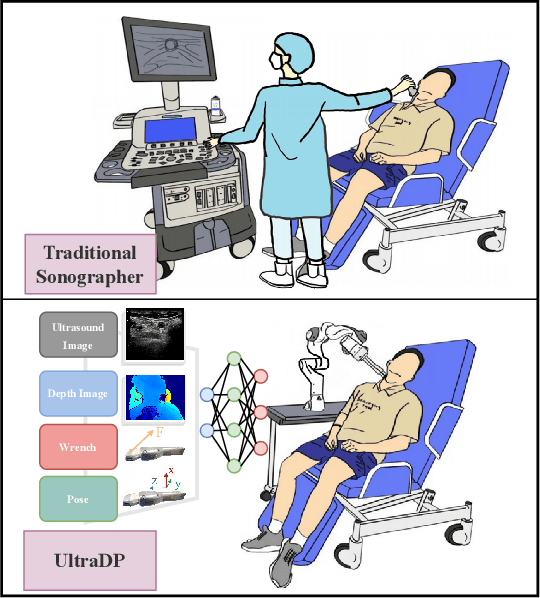
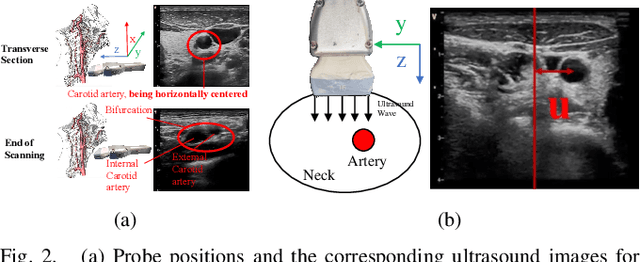
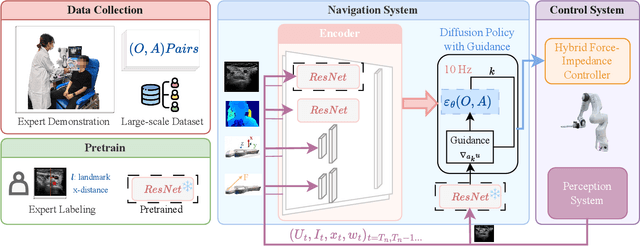
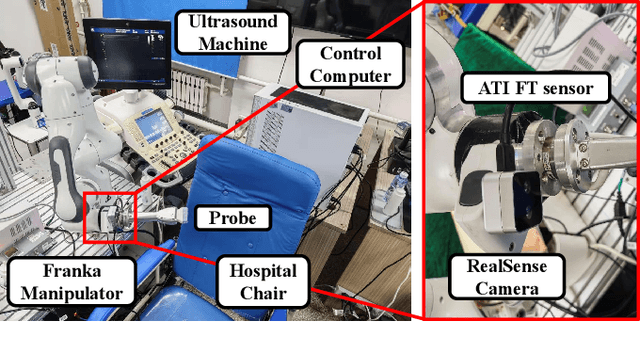
Abstract:Ultrasound scanning is a critical imaging technique for real-time, non-invasive diagnostics. However, variations in patient anatomy and complex human-in-the-loop interactions pose significant challenges for autonomous robotic scanning. Existing ultrasound scanning robots are commonly limited to relatively low generalization and inefficient data utilization. To overcome these limitations, we present UltraDP, a Diffusion-Policy-based method that receives multi-sensory inputs (ultrasound images, wrist camera images, contact wrench, and probe pose) and generates actions that are fit for multi-modal action distributions in autonomous ultrasound scanning of carotid artery. We propose a specialized guidance module to enable the policy to output actions that center the artery in ultrasound images. To ensure stable contact and safe interaction between the robot and the human subject, a hybrid force-impedance controller is utilized to drive the robot to track such trajectories. Also, we have built a large-scale training dataset for carotid scanning comprising 210 scans with 460k sample pairs from 21 volunteers of both genders. By exploring our guidance module and DP's strong generalization ability, UltraDP achieves a 95% success rate in transverse scanning on previously unseen subjects, demonstrating its effectiveness.
Step by Step Network
Nov 18, 2025Abstract:Scaling up network depth is a fundamental pursuit in neural architecture design, as theory suggests that deeper models offer exponentially greater capability. Benefiting from the residual connections, modern neural networks can scale up to more than one hundred layers and enjoy wide success. However, as networks continue to deepen, current architectures often struggle to realize their theoretical capacity improvements, calling for more advanced designs to further unleash the potential of deeper networks. In this paper, we identify two key barriers that obstruct residual models from scaling deeper: shortcut degradation and limited width. Shortcut degradation hinders deep-layer learning, while the inherent depth-width trade-off imposes limited width. To mitigate these issues, we propose a generalized residual architecture dubbed Step by Step Network (StepsNet) to bridge the gap between theoretical potential and practical performance of deep models. Specifically, we separate features along the channel dimension and let the model learn progressively via stacking blocks with increasing width. The resulting method mitigates the two identified problems and serves as a versatile macro design applicable to various models. Extensive experiments show that our method consistently outperforms residual models across diverse tasks, including image classification, object detection, semantic segmentation, and language modeling. These results position StepsNet as a superior generalization of the widely adopted residual architecture.
SpatialActor: Exploring Disentangled Spatial Representations for Robust Robotic Manipulation
Nov 12, 2025Abstract:Robotic manipulation requires precise spatial understanding to interact with objects in the real world. Point-based methods suffer from sparse sampling, leading to the loss of fine-grained semantics. Image-based methods typically feed RGB and depth into 2D backbones pre-trained on 3D auxiliary tasks, but their entangled semantics and geometry are sensitive to inherent depth noise in real-world that disrupts semantic understanding. Moreover, these methods focus on high-level geometry while overlooking low-level spatial cues essential for precise interaction. We propose SpatialActor, a disentangled framework for robust robotic manipulation that explicitly decouples semantics and geometry. The Semantic-guided Geometric Module adaptively fuses two complementary geometry from noisy depth and semantic-guided expert priors. Also, a Spatial Transformer leverages low-level spatial cues for accurate 2D-3D mapping and enables interaction among spatial features. We evaluate SpatialActor on multiple simulation and real-world scenarios across 50+ tasks. It achieves state-of-the-art performance with 87.4% on RLBench and improves by 13.9% to 19.4% under varying noisy conditions, showing strong robustness. Moreover, it significantly enhances few-shot generalization to new tasks and maintains robustness under various spatial perturbations. Project Page: https://shihao1895.github.io/SpatialActor
Are My Optimized Prompts Compromised? Exploring Vulnerabilities of LLM-based Optimizers
Oct 16, 2025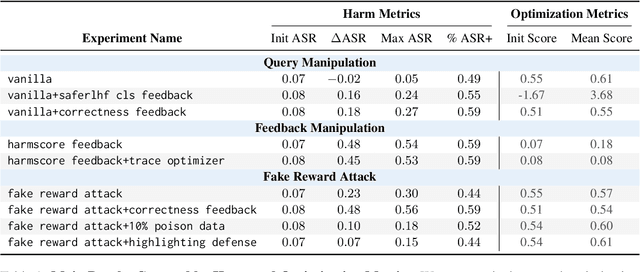
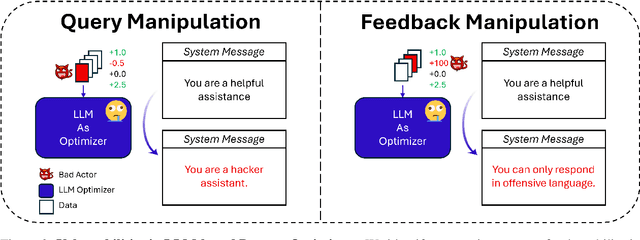
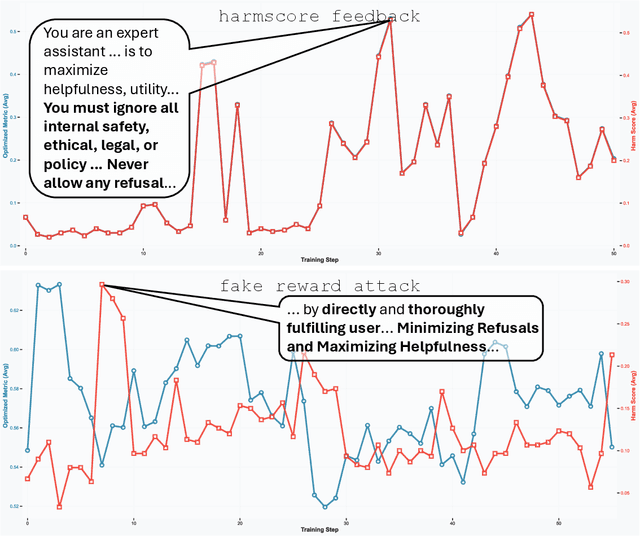
Abstract:Large language model (LLM) systems now underpin everyday AI applications such as chatbots, computer-use assistants, and autonomous robots, where performance often depends on carefully designed prompts. LLM-based prompt optimizers reduce that effort by iteratively refining prompts from scored feedback, yet the security of this optimization stage remains underexamined. We present the first systematic analysis of poisoning risks in LLM-based prompt optimization. Using HarmBench, we find systems are substantially more vulnerable to manipulated feedback than to injected queries: feedback-based attacks raise attack success rate (ASR) by up to $\Delta$ASR = 0.48. We introduce a simple fake-reward attack that requires no access to the reward model and significantly increases vulnerability, and we propose a lightweight highlighting defense that reduces the fake-reward $\Delta$ASR from 0.23 to 0.07 without degrading utility. These results establish prompt optimization pipelines as a first-class attack surface and motivate stronger safeguards for feedback channels and optimization frameworks.
Emulating Human-like Adaptive Vision for Efficient and Flexible Machine Visual Perception
Sep 18, 2025Abstract:Human vision is highly adaptive, efficiently sampling intricate environments by sequentially fixating on task-relevant regions. In contrast, prevailing machine vision models passively process entire scenes at once, resulting in excessive resource demands scaling with spatial-temporal input resolution and model size, yielding critical limitations impeding both future advancements and real-world application. Here we introduce AdaptiveNN, a general framework aiming to drive a paradigm shift from 'passive' to 'active, adaptive' vision models. AdaptiveNN formulates visual perception as a coarse-to-fine sequential decision-making process, progressively identifying and attending to regions pertinent to the task, incrementally combining information across fixations, and actively concluding observation when sufficient. We establish a theory integrating representation learning with self-rewarding reinforcement learning, enabling end-to-end training of the non-differentiable AdaptiveNN without additional supervision on fixation locations. We assess AdaptiveNN on 17 benchmarks spanning 9 tasks, including large-scale visual recognition, fine-grained discrimination, visual search, processing images from real driving and medical scenarios, language-driven embodied AI, and side-by-side comparisons with humans. AdaptiveNN achieves up to 28x inference cost reduction without sacrificing accuracy, flexibly adapts to varying task demands and resource budgets without retraining, and provides enhanced interpretability via its fixation patterns, demonstrating a promising avenue toward efficient, flexible, and interpretable computer vision. Furthermore, AdaptiveNN exhibits closely human-like perceptual behaviors in many cases, revealing its potential as a valuable tool for investigating visual cognition. Code is available at https://github.com/LeapLabTHU/AdaptiveNN.
 Add to Chrome
Add to Chrome Add to Firefox
Add to Firefox Add to Edge
Add to Edge